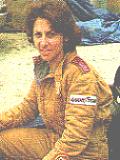

|
www.thundervalleyracing.com
|
|
The Brakes |
|||||
|
Part
1 of a series of technical articles
Brake systems in race cars today are consistent and dependable, yet need to be considered and maintained carefully for optimum performance. What drivers need to know and recognize are basic brake characteristics such as balance, fade and partswear information. The object of effective braking is to get all four tires to reach their limit of adhesion simultaneously. Stopping power is generated by two friction surfaces transferring energy into heat.
Threshold braking is braking at the maximum traction point. At this level of pressure on the brake pedal the tire has maximum grip for stopping. Beyond this point the tire will lock up. When the wheels are not rotating (lockup) the friction is between the tire and the road surface - result: flat spotted tires. As discussed in the article on tires, maximum tire traction for deceleration is about 10 to 15 % of slip. The car stops faster when the brakes are modulated just short of lockup. Brake energy is absorbed by the brake parts until it is dissipated as heat into the air stream. A typical racing brake application can generate 200-300 degrees in just a few seconds. Temperatures will accumulate to an average of 1000-1500 degrees at the disc face until stabilized, where heat input equals cooling output. BALANCE Because of weight transfer, the front and rear tires do not equally share braking loads. Since loading changes each tires traction capabilities, braking effort also changes. This difference is referred to as brake bias. Street cars have a preset bias either built into the brake master cylinder or with an inline proportioning valve.
Race cars use a balance bar system that the driver adjusts from the cockpit. The balance bar changes the hydraulic pressure between two master cylinders. One cylinder operating the front calipers, one operating the rear calipers, allowing more or less pressure to one cylinder when the pedal is pushed. To check the car's braking bias, check with the car on stands, wheels free. See how much force is needed to rotate the tires by hand, with the brakes applied. Because of weight transfer the front brakes are under more strain and they should require more force to turn the tire. Test at the track after all other chassis adjustments are set. With front bias the front wheels will lock up and the car will start to understeer. With rear bias the rear wheels will lock up on the straight and the car becomes unstable. The ideal is to have the rear wheels just starting to slow down after the front have already taken effect. The rear wheels should never brake before the front.
As fuel load and track conditions change, braking efficiency also changes. Adjustable bias allows the driver to compensate for these changes. When the track surface is less grippy, weight transfer, loading, front to rear decreases. Keeping the same bias will lock up the front tires. Use the brake balance control to switch some of the braking force from the front to the rear. Changing brake linings can also effect brake balance. Lining material is rated as a coefficient of friction, determined by the degree of hardness of its compounding. Soft linings have lots of friction but wear out quickly and tend to fade under severe use. Changing lining materials will make large changes in the car's braking efficiency. Test different compounds for different track conditions. Generally use the softest lining that does not wear out or fade. FADE Brake fade is a loss of brake performance caused by excess heat. From the driver's seat, even as you add force to the pedal the car does not slow down. There is excess travel in the pedal, sometimes to the floor and the pads feel oily. As the pads heat up the bonding material vaporizes and hot gas is trapped between the pad and the rotor, acting as a lubricant. Brake cooling ducts, slotted rotors and pads will help cooling. Air flow also keeps the fluid in the calipers cooler. Using a thin insulator between the caliper piston and the pad backing plate can make a difference of one hundred degrees. PARTS New brake pads must be bedded in before they are totally effective. Slowly run the pad up to maximum operating temperature and let the cool down slowly. Check the brake system completely.
BRAKE BLEEDING Fluid should be bled out of the calipers before every race. Always use fresh, high temperature fluid. Even unused fluid stored in an open container will absorb moisture from the air and lower its boiling point. Place a small amount of fresh fluid in a clean glass container, enough to submerge the end of the bleeding hose below the fluid level. The other end of the hose is placed on the inside bleeder of the caliper. Open the bleeder and have someone depress the brake pedal with his or her hand, slowly and with a steady motion. A stream of fluid empties into the container. Keep pressure on the pedal until the bleeder is closed, otherwise air could get drawn back into the system. Repeat until there is a clear, air bubble free flow of fluid from the caliper.
Check the reservoir and keep the level topped up. Make sure the hose is always submerged in the bleed bottle. Repeat the procedure on the outside bleeder. Do not force the brake pedal. The surge of fluid can generate air cavitation through the small orifices of the brake system. Avoid pressure bleeding, also because of fluid serge. Avoid silicon fluids for racing. In closing I am including an Internet post from a car club digest that illustrates brakes at work in competition - I recently sat next to a racer on a plane flight. He was returning home from competing at Mosport in a highly prepared Dodge Neon. The technique he described was very interesting. The Neon is front wheel drive, and so after the green flag drops, they hold the gas pedal to the floor and modulate the car's brakes and power with just the brake pedal. Without lifting from the gas at all, they slow the car into the turn by applying the brakes, trailing the brake into, and all the way out through the turn. They finally lift from the brake as they exit, and the car, still at open throttle, takes off like a shot. I asked about how this technique affects the brakes. He said they use the largest rotors they can find, and that the pads last a single race. The rotors start to glow after the green flag drops, and don't stop until the checker.
|
|
Home
| Member Area
|Meet the Racers
| Features | News Articles
Sponsorship
| Press Room
| Resources
| About Us
| Contact Us
|

